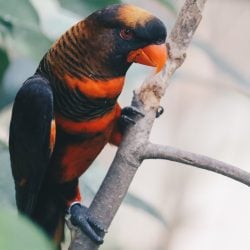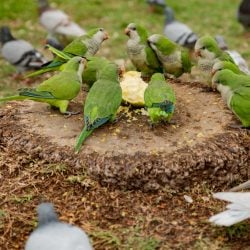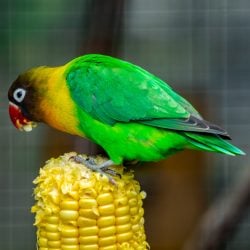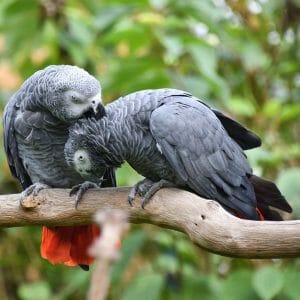Last Updated on by Mitch Rezman
Weighing your bird weekly is the best way to detect illness early. Birds are great at hiding illness and rapid weight change is a positive indicator that your bird needs further attention.
| AVERAGE WEIGHTS OF COMMON PET BIRDS | |||
|
|||
| TYPE | SPECIES | Average Weight (grams) | Average Chick Weight (grams) |
| AMAZONS | |||
| Blue-fronted | 275-510 (xanthopterys goes 400-500) | ||
| Cuban | 240 | 10 | |
| Double Yellow-headed | 450-650 | 15 | |
| Green-cheeked | 270 | ||
| Lilac-crowned | 325 | 11 | |
| Mealy | 540-700 | ||
| Orange-winged | 360-490 | ||
| Spectacled (White Front) | 205-235 | ||
| Tres Marias | 500 | ||
| Tucuman | 320 | ||
| Red-lored | 350 | ||
| Yellow-billed | 260 | ||
| Yellow-fronted | 380-480 | 12 | |
| Yellow-naped | 480-680 | ||
| Yellow-shouldered | 270 | 10 | |
| Vinaceous | 370 | ||
| CAIQUES | |||
| Black-headed | 145-170 | 8 | |
| White-bellied | 165 | 7 | |
| COCKATOOS | |||
| Galah | 345 | ||
| GangGang | 280 | ||
| Goffin’s | 221-386 | 10 | |
| Greater Sulphur-crested | 880 | ||
| Lesser Sulphur-crested | 350 | ||
| Moluccan | 640-1025 | 20 | |
| Palm | 900 (Adults range from 600-1000) | 18 | |
| Rose-breasted | 281-390 | ||
| Umbrella | 458-750 | 18 | |
| CONURE | |||
| Blue-crowned | 84-100 | ||
| Dusky | 90 | ||
| Greater Patagonian | 315-390 | 12 | |
| Green-cheeked | 60-80 | 5 | |
| Jenday | 120 | ||
| Lesser Patagonian | 240-310 | 10 | |
| Mitred | 200 | 11 | |
| Nanday | 140 | ||
| Orange-fronted | 73 | ||
| Painted | 55 | ||
| Queen of Bavaria’s | 270 | ||
| Red-masked | 200 | ||
| Sun | 100-130 | ||
| Whiteeyed | 140 | ||
| LORY | |||
| Blue-streaked | 160 | ||
| Chattering | 200 | ||
| Dusky | 155 | 7 | |
| Rainbow | 130 | 5 | |
| Red | 170 | ||
| LOVEBIRD | |||
| Fisher’s | 50 | ||
| Masked | 50 (most females weigh more than males) | ||
| Peach-faced | 55 | ||
| MACAW | |||
| Blue and Gold | 800-1292 | 20 | |
| Green-winged | 900-1529 | 21 | |
| Catalina | 900-1500 | ||
| Hahn’s | 165 | ||
| Hyacinth | 1200-1450 | 25 | |
| Illiger’s | 265 | 11 | |
| Lear’s | 940 | ||
| Military | 900 | 18-20 | |
| Noble | 190 | ||
| Red-fronted | 525 | ||
| Scarlet | 900-1100 | 21 | |
| Severe | 360 | ||
| Spix’s | 360 | ||
| Yellow-collared | 250 | 12 | |
| MISC | |||
| African Ringneck | 105 | ||
| Canary | 12-29 | ||
| Cockatiel | 90 | 4-5 | |
| Eclectus | 375-550 | 16 | |
| Indian Ringneck | 115 | ||
| Kea | 1000 | ||
| Pacific Parrotlet | 31-34 | ||
| Red-fronted Kakariki | 100 | ||
| St. Vincent | 580-700 | ||
| Zebra Finch | 10-16 | ||
| PARAKEET | |||
| Alexandrine | 250 | ||
| Barraband’s | 140 | 5 | |
| Bourke’s | 50 | ||
| Budgerigar | 25-60 | ||
| Canary-winged | 70 | ||
| Crimson Rosella | 145 | ||
| Derbyan | 320 | ||
| Golden-manteled | 100 | ||
| Grey-cheeked | 45-60 | ||
| Moustache | 110-140 | ||
| Plum-headed | 90 | 5 | |
| Quaker or Monk | 90-150 | ||
| Red-rumped | 60 | ||
| PARROTS | |||
| Brown-headed | 125 | ||
| Cape | 320 | 12 | |
| Great-billed | 260 | 13.5 | |
| Greater Vasa | 480 | ||
| Grey | 380-554 | 12-14 | |
| Hawk-headed | 250 | 11 | |
| Jardine’s | 200 | 10 | |
| Lesser Vasa | 280 | ||
| Meyer’s | 120 | 5 | |
| Pesquet’s | 700 | 18 | |
| Red-bellied | 125 | 7 | |
| Scarlet-chested | 40 | ||
| Senegal | 110-130 | 6 | |
| Timneh Grey | 300-360 | 12 | |
| PIONUS | |||
| Blue-headed | 230-260 | ||
| Bronze-winged | 210 | ||
| Dusky | 200 | 9 | |
| White-capped | 180 | ||
Author Profile
Latest entries
 Bird BehaviorJune 26, 2025How is it Parrots Are Problem Solvers Social Animals and Even Use Tools?
Bird BehaviorJune 26, 2025How is it Parrots Are Problem Solvers Social Animals and Even Use Tools? Bird & Parrot AnatomyJune 25, 2025How a Tiny Chemical Modification Makes Parrots Nature’s Living Paintings
Bird & Parrot AnatomyJune 25, 2025How a Tiny Chemical Modification Makes Parrots Nature’s Living Paintings PigeonsJune 20, 2025How Do Parrots Thrive in Cities Outside Their Native Habitats?
PigeonsJune 20, 2025How Do Parrots Thrive in Cities Outside Their Native Habitats? Feeding Exotic BirdsJune 20, 2025Is Corn On the Cob Safe for Pet Birds?
Feeding Exotic BirdsJune 20, 2025Is Corn On the Cob Safe for Pet Birds?




